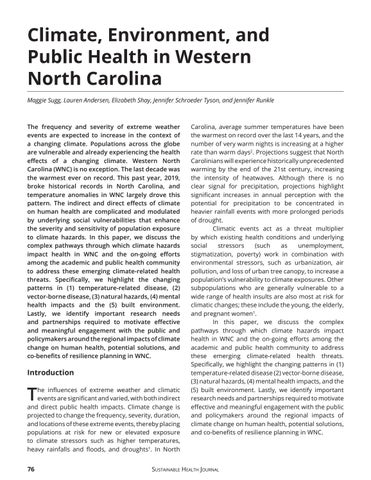Climate, Environment, and Public Health in Western North Carolina Maggie Sugg, Lauren Andersen, Elizabeth Shay, Jennifer Schroeder Tyson, and Jennifer Runkle
The frequency and severity of extreme weather events are expected to increase in the context of a changing climate. Populations across the globe are vulnerable and already experiencing the health effects of a changing climate. Western North Carolina (WNC) is no exception. The last decade was the warmest ever on record. This past year, 2019, broke historical records in North Carolina, and temperature anomalies in WNC largely drove this pattern. The indirect and direct effects of climate on human health are complicated and modulated by underlying social vulnerabilities that enhance the severity and sensitivity of population exposure to climate hazards. In this paper, we discuss the complex pathways through which climate hazards impact health in WNC and the on-going efforts among the academic and public health community to address these emerging climate-related health threats. Specifically, we highlight the changing patterns in (1) temperature-related disease, (2) vector-borne disease, (3) natural hazards, (4) mental health impacts and the (5) built environment. Lastly, we identify important research needs and partnerships required to motivate effective and meaningful engagement with the public and policymakers around the regional impacts of climate change on human health, potential solutions, and co-benefits of resilience planning in WNC.
Introduction
T
he influences of extreme weather and climatic events are significant and varied, with both indirect and direct public health impacts. Climate change is projected to change the frequency, severity, duration, and locations of these extreme events, thereby placing populations at risk for new or elevated exposure to climate stressors such as higher temperatures, heavy rainfalls and floods, and droughts1. In North 76
Carolina, average summer temperatures have been the warmest on record over the last 14 years, and the number of very warm nights is increasing at a higher rate than warm days2. Projections suggest that North Carolinians will experience historically unprecedented warming by the end of the 21st century, increasing the intensity of heatwaves. Although there is no clear signal for precipitation, projections highlight significant increases in annual perception with the potential for precipitation to be concentrated in heavier rainfall events with more prolonged periods of drought. Climatic events act as a threat multiplier by which existing health conditions and underlying social stressors (such as unemployment, stigmatization, poverty) work in combination with environmental stressors, such as urbanization, air pollution, and loss of urban tree canopy, to increase a population’s vulnerability to climate exposures. Other subpopulations who are generally vulnerable to a wide range of health insults are also most at risk for climatic changes; these include the young, the elderly, and pregnant women1. In this paper, we discuss the complex pathways through which climate hazards impact health in WNC and the on-going efforts among the academic and public health community to address these emerging climate-related health threats. Specifically, we highlight the changing patterns in (1) temperature-related disease (2) vector-borne disease, (3) natural hazards, (4) mental health impacts, and the (5) built environment. Lastly, we identify important research needs and partnerships required to motivate effective and meaningful engagement with the public and policymakers around the regional impacts of climate change on human health, potential solutions, and co-benefits of resilience planning in WNC.
Sustainable Health Journal
